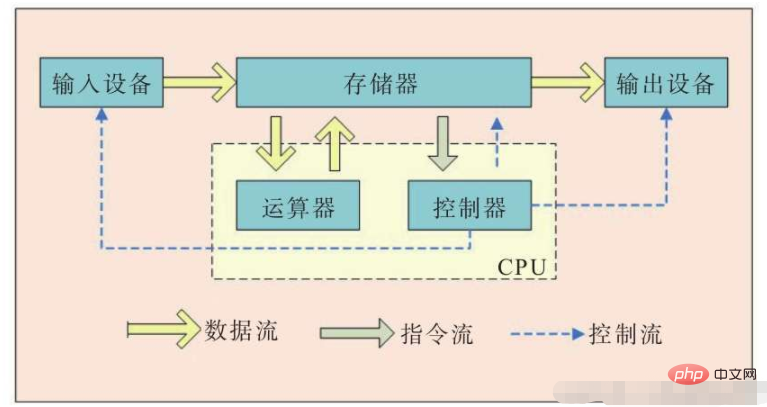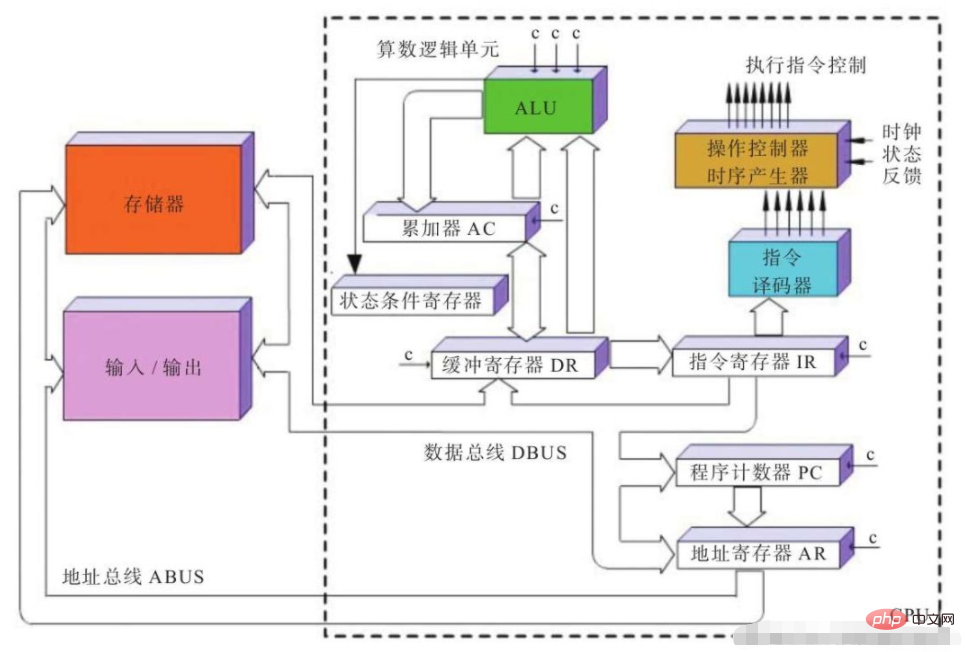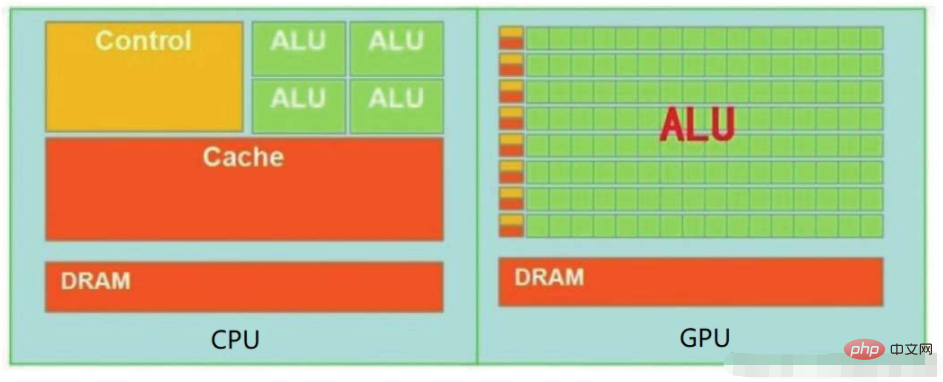What is the relationship between gpu and cpu
GPU is the graphics processor of the computer, and CPU is the central processing unit of the computer. The GPU reduces the graphics card's dependence on the CPU and performs some of the original CPU's work. GPU is a microprocessor that is specialized in image and graphics-related calculations on personal computers and some mobile devices to achieve graphics acceleration. The most important thing now is to achieve 3D graphics acceleration.

The operating environment of this tutorial: Windows 7 system, Dell G3 computer.
What are gpu and cpu? What's the relationship between the two?
gpu is the graphics processor of the computer, and cpu is the central processing unit of the computer.
CPU is generally composed of a logical operation unit, a control unit and a storage unit. It is the final execution unit for information processing and program execution. GPU is a microprocessor that is specialized in image and graphics-related operations on personal computers and some mobile devices to achieve graphics acceleration. The most important thing now is to achieve 3D graphics acceleration. The number of cores of GPU far exceeds that of CPU and is called many cores, but the cache size of each core is relatively small.
The GPU reduces the graphics card's dependence on the CPU and performs some of the original CPU's work, especially in 3D graphics processing. The core technologies used by the GPU include hardware T&L (geometry conversion and lighting processing), cubic environment Material mapping and vertex blending, texture compression and bump mapping, dual texture four-pixel 256-bit rendering engine, etc., and hardware T&L technology can be said to be the hallmark of GPU. The main manufacturers of GPUs are NVIDIA and ATI.

Extended knowledge: Introduction to GPU (Graphics Processing Unit)
Graphics Processor
CPU consists of two major components: Arithmetic Unit (ALU) and Controller (CU) . In addition, there are several registers and cache memories and data, control and status buses that connect them. The ALU is used to perform arithmetic operations, shift operations, address operations and conversions; the register device is used to save intermediate data and instructions; the CU is responsible for decoding instructions and issuing control signals for each operation to be performed to complete each instruction.

The operation of the CPU follows the Von Neumann architecture: stored program sequential execution. The program execution process is as follows:
The CPU obtains instructions from the memory according to the program counter (
Program Counter, PC), and then sends the instructions to the decoder through the instruction bus, and translates them The subsequent instructions are handed over to the timing generator and operation controller, and then the data is obtained from the memory and processed by the arithmetic unit. Finally, the data is stored in the data cache register and memory through the data bus.
CPU processes data step by step. When processing large-scale and high-speed data, it is difficult for the CPU to meet the needs.

When the integration level of the chip increases, the leakage current also increases, but the increase in clock frequency is limited, and the line width of the transistor will soon reach the physical limit , so the performance of the chip is difficult to improve by reducing the transistor line width. As a result, people began to make a fuss about the design. The first thing they thought of was to let multiple processors work in parallel, which naturally improved the efficiency a lot, so multi-core CPUs and GPUs were born.
Another idea is to keep the chip unchanged and add artificial intelligence to the application system to obtain computing benefits. With the advent of the big data era, there are more and more artificial intelligence-oriented application systems. In modern computers, graphics processing is becoming more and more important, so a core processor GPU that specializes in graphics processing has emerged. For processing graphics data, every pixel on the graphics must be processed, which is a big data, so the requirements for computing speed are very high. However, the functions required by the GPU are relatively simple, so the GPU architecture based on optimized graphics processing was born.
 #CPU has many functional modules and is suitable for complex computing environments. Most of the transistors are used in the control circuit and Cache, and a small number of transistors are used to complete computing work. The control of the GPU is relatively simple and does not require a large Cache. Most transistors can be used in various special circuits and pipelines.
#CPU has many functional modules and is suitable for complex computing environments. Most of the transistors are used in the control circuit and Cache, and a small number of transistors are used to complete computing work. The control of the GPU is relatively simple and does not require a large Cache. Most transistors can be used in various special circuits and pipelines.
.
The current multi-core CPU is generally composed of 4 or 6 cores, which simulates 8 or 12 processing processes to calculate. But ordinary GPUs contain hundreds of cores, and high-end ones have tens of thousands of cores. This has a natural advantage for a large number of repeated processing processes in multimedia processing, and more importantly, it can be used to process large-scale parallel data deal with. Although the GPU is designed for image processing, its architecture does not have a dedicated image processing algorithm. It only optimizes the CPU architecture. Therefore, the GPU is not only widely used in image processing, but also It is widely used in fields that require parallel computing, such as scientific computing, password cracking, numerical analysis, big data processing, and financial analysis. GPU is a more general professional chip. Composition of graphics processor The circuit board of GPU is generally a 6-layer or 4-layer PCB circuit board. All components of the GPU are integrated on its circuit board, and the circuit board affects the quality of the GPU. GPU The largest chip on the circuit board is the GPU, which has a heat sink and a fan. As the core of data processing, most GPUs adopt a single-chip design, while professional GPUs also use multiple GPU chips. Another important chip on the GPU circuit board is the GPU data is stored in the video memory, and the video memory is used to store graphics data information waiting to be processed. Video memory capacity determines the resolution and color depth supported by the GPU. The higher the resolution, the more pixels are displayed and the larger the video memory capacity required. For current 3D GPUs, a large amount of video memory is required to store Z-Buffer data or material data. There are two major categories of video memory: Common types of capacitors used on GPU circuit boards include electrolytic capacitors, tantalum capacitors, etc. The former generates greater heat. Many famous brand GPUs use tantalum capacitors to improve performance. The same is true for resistors. Common metal film resistors and carbon film resistors are increasingly giving way to chip resistors. The GPU circuit board has a power supply circuit that supplies power to the GPU. Its role is to adjust the current from the motherboard for the GPU to work stably. As GPUs become more and more sophisticated, the requirements for GPU power supply circuits are also getting higher and higher. There is also a flash memory for VGA BIOS on the GPU circuit board. It contains information such as GPU and driver control programs, product identification, etc. This flash memory can be upgraded through a dedicated program to improve GPU performance and sometimes give the GPU a makeover. The GPU circuit board has components such as crystal oscillators that provide the digital/analog conversion clock frequency to the inside of the GPU. In addition, since the frequency of the GPU is getting higher and higher, it generates a lot of heat when working, and there will also be a cooling fan on the GPU circuit board. For more related knowledge, please visit the FAQ column! digital/analog converter (RAMDAC). Its function is to convert the digital signal in the video memory into an analog signal that the monitor can recognize. The speed is in MHz as the unit. The faster the speed, the more stable the image. It determines the maximum speed that the GPU can support. Refresh frequency. In order to reduce costs, most manufacturers have integrated digital/analog converters into GPU chips, but there are still some high-end GPUs that use independent digital/analog converter chips. Single-ended and Double-ended video memory. The former reads data from the GPU and transmits the data to the digital/analog converter through the same port. Data reading, writing and transmission cannot be performed at the same time; the latter can read, write and transmit data at the same time. Currently popular video memories include SDRAM, SGRAM, DDR RAM, VRAM, WRAM, etc.
The above is the detailed content of What is the relationship between gpu and cpu. For more information, please follow other related articles on the PHP Chinese website!

Hot AI Tools

Undresser.AI Undress
AI-powered app for creating realistic nude photos

AI Clothes Remover
Online AI tool for removing clothes from photos.

Undress AI Tool
Undress images for free

Clothoff.io
AI clothes remover

AI Hentai Generator
Generate AI Hentai for free.

Hot Article

Hot Tools

Notepad++7.3.1
Easy-to-use and free code editor

SublimeText3 Chinese version
Chinese version, very easy to use

Zend Studio 13.0.1
Powerful PHP integrated development environment

Dreamweaver CS6
Visual web development tools

SublimeText3 Mac version
God-level code editing software (SublimeText3)

Hot Topics
 1378
1378
 52
52
 The operation process of WIN10 service host occupying too much CPU
Mar 27, 2024 pm 02:41 PM
The operation process of WIN10 service host occupying too much CPU
Mar 27, 2024 pm 02:41 PM
1. First, we right-click the blank space of the taskbar and select the [Task Manager] option, or right-click the start logo, and then select the [Task Manager] option. 2. In the opened Task Manager interface, we click the [Services] tab on the far right. 3. In the opened [Service] tab, click the [Open Service] option below. 4. In the [Services] window that opens, right-click the [InternetConnectionSharing(ICS)] service, and then select the [Properties] option. 5. In the properties window that opens, change [Open with] to [Disabled], click [Apply] and then click [OK]. 6. Click the start logo, then click the shutdown button, select [Restart], and complete the computer restart.
 144-core, 3D-stacked SRAM: Fujitsu details next-generation data center processor MONAKA
Jul 29, 2024 am 11:40 AM
144-core, 3D-stacked SRAM: Fujitsu details next-generation data center processor MONAKA
Jul 29, 2024 am 11:40 AM
According to news from this website on July 28, foreign media TechRader reported that Fujitsu introduced in detail the FUJITSU-MONAKA (hereinafter referred to as MONAKA) processor planned to be shipped in 2027. MONAKACPU is based on the "cloud native 3D many-core" architecture and adopts the Arm instruction set. It is oriented to the data center, edge and telecommunications fields. It is suitable for AI computing and can realize mainframe-level RAS1. Fujitsu said that MONAKA will achieve a leap in energy efficiency and performance: thanks to technologies such as ultra-low voltage (ULV) technology, the CPU can achieve 2 times the energy efficiency of competing products in 2027, and cooling does not require water cooling; in addition, the application performance of the processor It can also reach twice as much as your opponent. In terms of instructions, MONAKA is equipped with vector
 Do I need to enable GPU hardware acceleration?
Feb 26, 2024 pm 08:45 PM
Do I need to enable GPU hardware acceleration?
Feb 26, 2024 pm 08:45 PM
Is it necessary to enable hardware accelerated GPU? With the continuous development and advancement of technology, GPU (Graphics Processing Unit), as the core component of computer graphics processing, plays a vital role. However, some users may have questions about whether hardware acceleration needs to be turned on. This article will discuss the necessity of hardware acceleration for GPU and the impact of turning on hardware acceleration on computer performance and user experience. First, we need to understand how hardware-accelerated GPUs work. GPU is a specialized
 Leak reveals key specs of Intel Arrow Lake-U, -H, -HX and -S
Jun 15, 2024 pm 09:49 PM
Leak reveals key specs of Intel Arrow Lake-U, -H, -HX and -S
Jun 15, 2024 pm 09:49 PM
IntelArrowLakeisexpectedtobebasedonthesameprocessorarchitectureasLunarLake,meaningthatIntel'sbrandnewLionCoveperformancecoreswillbecombinedwiththeeconomicalSkymontefficiencycores.WhileLunarLakeisonlyavailableasava
 AM4 refuses to die, news says AMD will launch Ryzen 9 5900XT/7 5800XT: clocked at up to 4.8GHz
Jun 05, 2024 pm 09:43 PM
AM4 refuses to die, news says AMD will launch Ryzen 9 5900XT/7 5800XT: clocked at up to 4.8GHz
Jun 05, 2024 pm 09:43 PM
According to news from this website on June 1st, the source @CodeCommando tweeted today, sharing some screenshots of AMD’s upcoming presentation documents at the Computex2024 event. The content of the tweet was “AM4 will never die”, and the accompanying picture showed two new Ryzen5000XT series processors. The screenshots show the following two products: Ryzen 95900 Ryzen75800XT It is a faster variant of AMD's existing Ryzen75800X processor. Both processors are clocked up to 4.8G
 Beelink EX graphics card expansion dock promises zero GPU performance loss
Aug 11, 2024 pm 09:55 PM
Beelink EX graphics card expansion dock promises zero GPU performance loss
Aug 11, 2024 pm 09:55 PM
One of the standout features of the recently launched Beelink GTi 14is that the mini PC has a hidden PCIe x8 slot underneath. At launch, the company said that this would make it easier to connect an external graphics card to the system. Beelink has n
 Super practical! Sar commands that will make you a Linux master
Mar 01, 2024 am 08:01 AM
Super practical! Sar commands that will make you a Linux master
Mar 01, 2024 am 08:01 AM
1. Overview The sar command displays system usage reports through data collected from system activities. These reports are made up of different sections, each containing the type of data and when the data was collected. The default mode of the sar command displays the CPU usage at different time increments for various resources accessing the CPU (such as users, systems, I/O schedulers, etc.). Additionally, it displays the percentage of idle CPU for a given time period. The average value for each data point is listed at the bottom of the report. sar reports collected data every 10 minutes by default, but you can use various options to filter and adjust these reports. Similar to the uptime command, the sar command can also help you monitor the CPU load. Through sar, you can understand the occurrence of excessive load
 AMD FSR 3.1 launched: frame generation feature also works on Nvidia GeForce RTX and Intel Arc GPUs
Jun 29, 2024 am 06:57 AM
AMD FSR 3.1 launched: frame generation feature also works on Nvidia GeForce RTX and Intel Arc GPUs
Jun 29, 2024 am 06:57 AM
AMD delivers on its initial March ‘24 promise to launch FSR 3.1 in Q2 this year. What really sets the 3.1 release apart is the decoupling of the frame generation side from the upscaling one. This allows Nvidia and Intel GPU owners to apply the FSR 3.



